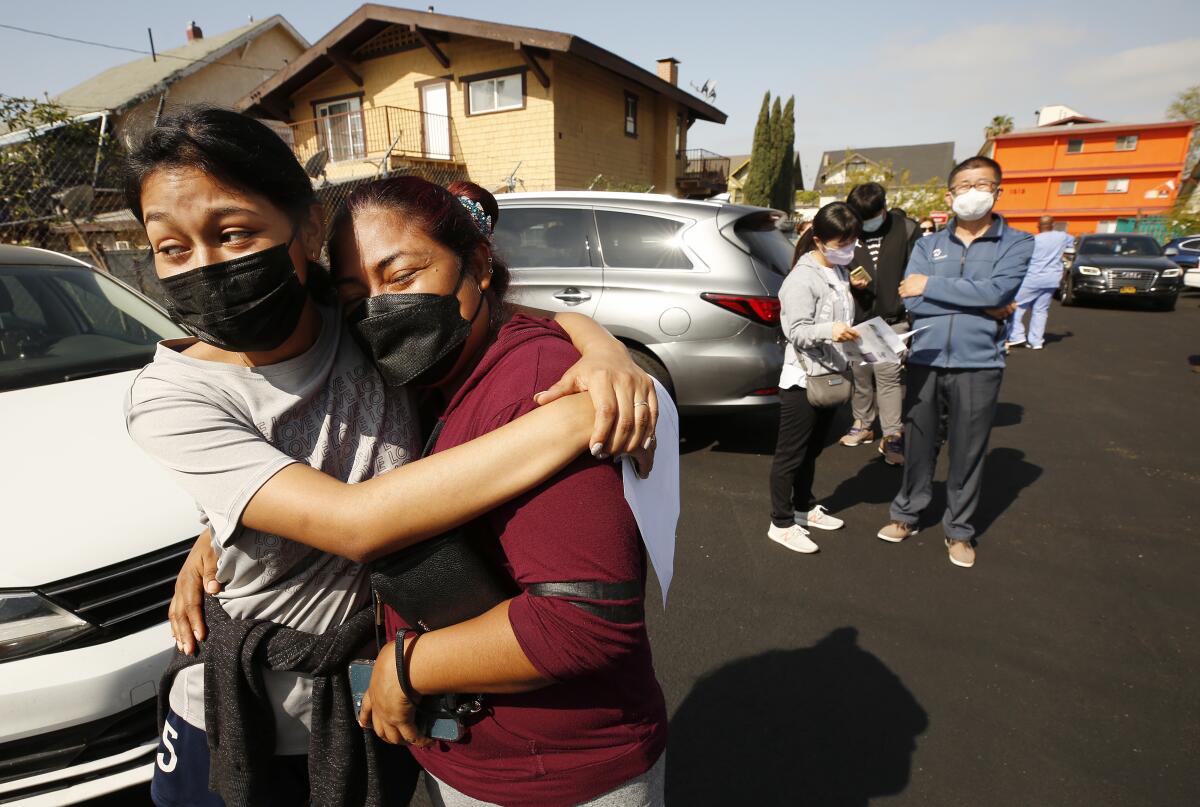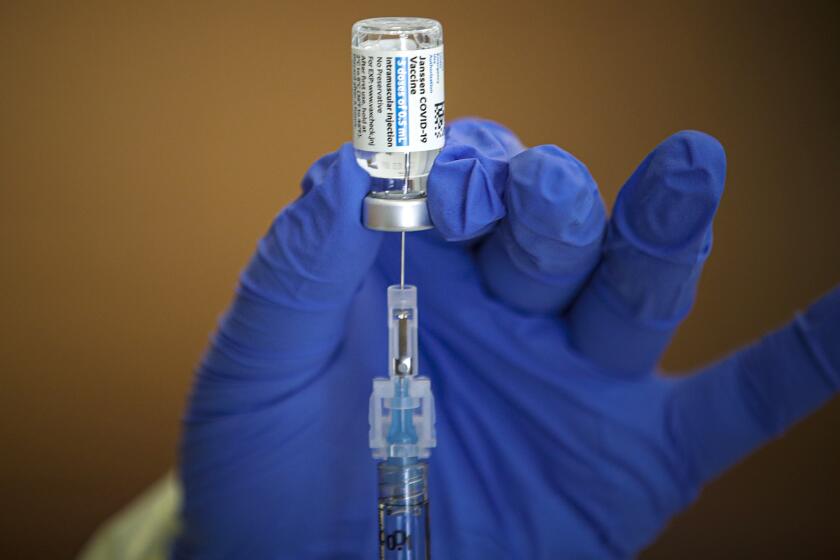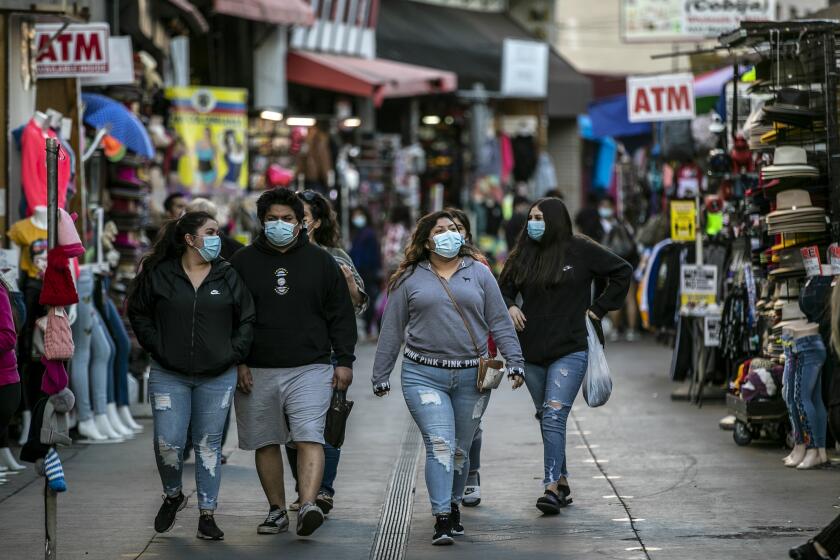There’s growing confidence that the worst of COVID-19 is behind California

- Share via
California’s battle against coronavirus has progressed so rapidly in the last few months that many experts are optimistic that the state has experienced the worst of the pandemic and that another disastrous wave is unlikely as vaccinations increase and case rates keep plunging.
If those forecasts hold fast, California will enter the summer in a better place than many thought. State officials hope to have the economy largely reopened by June 15. And while coronavirus variants caused concerns earlier this year, officials and experts say they have generally been less aggressive than feared and vaccines seem to be offering protection against the variants.
“I am optimistic,” said Dr. Robert Kim-Farley, medical epidemiologist and infectious diseases expert at the UCLA Fielding School of Public Health. “I think that we are going in the right direction — we will never have a surge like we had during the viral tsunami of the post-holiday season, just because now we have so many people vaccinated, and so many people have got natural immunity from having had the disease.”
Kim-Farley and others have said it’s always possible the virus could come back in some areas where people refuse to take the vaccine.
“We may see some increases from time to time, especially if the virus gets into pockets of unimmunized people. But we’re not going to see these major threats that occurred to us previously,” Kim-Farley said.
Average daily vaccinations in California have declined in recent weeks. But officials are hoping for a surge of interest starting Thursday, when adolescents ages 12 to 15 are expected to become eligible for vaccine appointments — and those could be opportunities to encourage other family members to get their shots.
California is hiring 2,000 canvassers to phone-bank and knock on doors, and is running a flurry of ads and testimonials about COVID-19 vaccines.
On Monday, officials said Los Angeles County‘s adults and oldest teenagers could reach “herd immunity” from the coronavirus by mid- to late July. Herd immunity, sometimes referred to as community immunity, occurs when enough people have been inoculated or have obtained natural immunity to protect the larger population against the virus.
With about 400,000 shots administered weekly, the county has about 2 million first doses to go before 80% of all residents 16 and older will have received at least one shot, Los Angeles County Public Health Director Barbara Ferrer said in a news briefing.
Ferrer noted that the estimated population that needs to be vaccinated in L.A. County for herd immunity is a guess, “but we do assume it’s probably somewhere around 80%.”
California is progressing to a situation where there’s markedly diminished transmission because there is a decreasing number of people vulnerable to the coronavirus, because of either vaccination or prior infection, Kim-Farley said.
While it’s unlikely California will get to the point where there will be zero new daily cases and the virus is eliminated, “I do feel very confident that we are turning the corner, getting to that light at the end of the tunnel that’s been promised — of markedly reducing the number of cases that allows us then to be able to start dialing back on all these restrictions because of the fact that community rates of transmission are becoming very, very low,” Kim-Farley said.
Generally speaking, different regions of California may move faster than others.
Dr. George Rutherford, an epidemiologist at UC San Francisco, believes the Bay Area will see some form of herd immunity first — perhaps by mid-June or early July — followed by urban and suburban Southern California and agricultural California at some point after that.
Even after the CDC said fully vaccinated Americans could stop wearing masks outdoors unless they’re in a crowd of strangers, many in L.A. still mask up.
But that’s all contingent on vaccine rates remaining steady and not declining more steeply than they have recently.
In addition, scientists are increasingly confident that vaccines available in the U.S. “to a certain extent are protective from severe disease across all variants,” said Dr. Catherine Blish, a Stanford University professor of medicine and infectious diseases. “And that is really very good news.”
There are now nine California counties, accounting for 12 million residents, that are in the state’s least restrictive yellow tier, allowing businesses to open to the maximum extent possible under the statewide color-coded framework for pandemic regulations.
The two most populous are Los Angeles and San Francisco counties, and both have among the lowest average daily new coronavirus case rates over the past week of California’s 58 counties.
L.A. and San Francisco counties show how different paths exist for getting past the pandemic. While San Francisco, with a population of fewer than 900,000, did see increased cases in the autumn and winter surge, its hospitals were never slammed like those in L.A. County. San Francisco has recorded 538 COVID-19 deaths over the course of the pandemic, for a death rate of 62 per 100,000 residents.
San Francisco also has one of the highest rates of vaccination in California, with 66% of its residents having received at least one dose.
Los Angeles County, meanwhile, trod a far more deadly path to reaching low new daily case rates — a death rate nearly quadruple that of San Francisco’s. L.A. County has recorded more than 24,000 deaths from COVID-19, for a rate of 238 deaths per 100,000 residents, one of the highest in the state.
“That’s why you’re seeing these crashing rates [of the coronavirus in L.A. County] — because there’s so much naturally acquired infection,” Rutherford said.
In L.A. County, home to 10.1 million, about 49% of residents have received at least one dose of the vaccine. But the L.A. County Department of Health Services estimates that perhaps 63% of county residents have immunity to the virus, either because they’ve been vaccinated or because they’ve survived the illness.
Some experts suspect L.A. County was hit harder than San Francisco for a number of reasons, including higher levels of poverty and crowded housing, but also because of more skepticism toward mask mandates and business restrictions. Polls have shown that Bay Area residents have been more supportive of pandemic-related restrictions than Southern California residents.
California still needs to maintain a decent pace of vaccinations to keep COVID-19 infections at bay. High rates of vaccine hesitancy, even if limited to pockets of communities, can still result in flareups of the disease. For instance, the introduction of a really transmissible variant, such as the one first identified in the United Kingdom (B.1.1.7), “can spread like wildfire through an unvaccinated community,” Blish said.
“We really need to keep vaccinating. ... I’d really like to see us pushing up to 80% of population, given the incredible transmissibility of B.1.1.7,” Blish said.
Earlier this year, the emergence of COVID-19 variants raised concerns. But studies have offered reassurance that existing vaccines work well against the two most dominant strains in California — B.1.1.7 and the homegrown variant identified in California (B.1.427/B.1.429).
“Everything we’ve seen with the variants should provide marked reassurance, as far as the protection that is afforded by vaccines — particularly the vaccines that we have in the United States,” said Dr. Eric Topol, director of the Scripps Research Translational Institute in La Jolla.
Times staff writer Hayley Smith contributed to this report.
More to Read
Sign up for Essential California
The most important California stories and recommendations in your inbox every morning.
You may occasionally receive promotional content from the Los Angeles Times.













